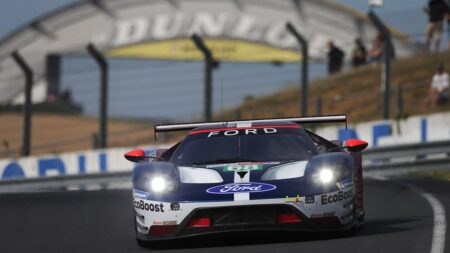
McLaren wants to win 2027 Triple Crown with Le Mans Hypercar
McLaren will enter the Le Mans Hypercar class for the very first time in 2027 – and is gunning to win motor sport's 'Triple Crown' all in one year
Stints are an important part of endurance racing, but some in the pitlane don’t have that luxury
When you’re hunkering down at Le Mans at 3am into your sleeping bag, spare a thought for some of these men and women.
Despite their bright yellow and black overalls, or blue and white elsewhere in the pitlane, they are barely noticed as they busily go about their work. While others in the team can work in shifts, these are solitary figures embedded within – all that separates them is the branding on their suits.
They are tyre engineers, with a simple enough task on the face of it. “It’s really only four numbers we have to check, eight if you count the temperatures,” one of Dunlop’s tyre engineers Simon says during the first practice session of the season at the 6 Hours of Silverstone. His eyes intermittently flick left as his radio chirps in his ear. He’s always listening, primed and ready in case any of those four numbers are acting up.
“We set the pressures before each session, it’s rare drivers dictate anything like that,” he says once safe to ignore the chatter in his ear.
The session is all about monitoring. Watching the timing screens “out of curiosity more than anything”, and the telemetry for anything amiss. He scurries into the firing line of the pitlane when chance allows to get a track reading.
“Our readers are calibrated so we know we can trust it and get an average to work off. The temperature will vary compared to where you are on track but it’s still useful. Our engineers will be taking it up and down the pitlane so we get an almost constant gauge. This morning’s ELMS session at 9am was a little bit irrelevant for us because it’s nowhere near race time, so temperature then doesn’t really matter.”
The car comes in on the schedule his earpiece tells him, and he quietly stabs each tyre at three points across the tyre for his readings and for the pressure, each recorded in his notepad as those about him work around him like he’s not there.
More waiting, more listening, more watching, and then the car is wheeled into the garage on stands. The circuit being Silverstone the left side of the car does most of the work, which is where he’s disappeared to. Checked, recorded, brief conflab and a shrug of nothing to report. He stands down.
It’s like this throughout, but consider Le Mans. “We don’t sleep. There are rotas at the Nürburgring but not at Le Mans. It’s tough.”
When the session ends it’s to work. Each tyre has a patch that he’ll check for wear by scraping away the pick-up and debris to then note his readings. In a race, that’s what will keep him busy after each tyre change. And at Le Mans there will be a pitstop at least every 40 minutes or so, and there could be one at any time.
The data and the session’s recordings will go back to the team to analyse, but also to Dunlop in the debrief.
“It’s difficult because we’re on the same team but there’s also a lot of competition between us,” says Simon. “We want to be the quickest Dunlop car. But we also need to report on the session.”
The new LMP2 cars are fast and the tyres will be enduring more stress and load than ever before at Le Mans, on quadruple stints. The recent test day saw them lapping 8.2sec faster than in 2016, and the time is expected to come down again in qualifying. So the eyes will be on those numbers with ever more scrutiny.
Simon and his 15 tired, tireless colleagues are in for a busy 24 hours.

McLaren will enter the Le Mans Hypercar class for the very first time in 2027 – and is gunning to win motor sport's 'Triple Crown' all in one year

A Ford GT40 MkII which managed 12 laps at the famous 1966 Le Mans 24 Hours has become been auctioned for a record amount

Two of racing's biggest rivals are on collision course once more, with the Ford v Ferrari battle for overall Le Mans victory due to resume in 2027 after six decades — and Ford is already talking up the fight

Ford will develop a new top-tier sports car to compete for overall victory in the Le Mans 24 Hours and the World Endurance Championship Hypercar class from 2027 onwards, aiming to continue where its GT40 left off in the 1960s